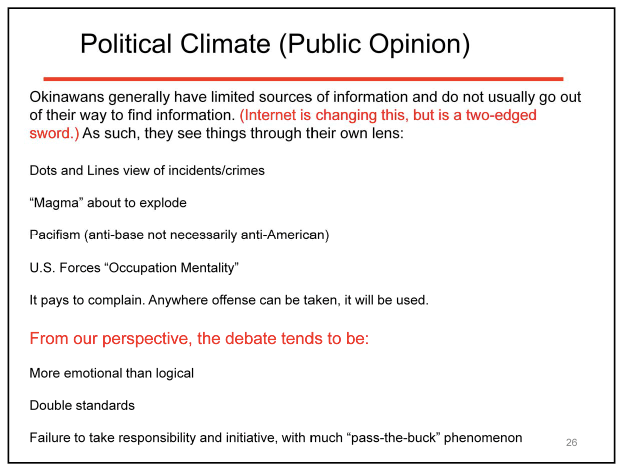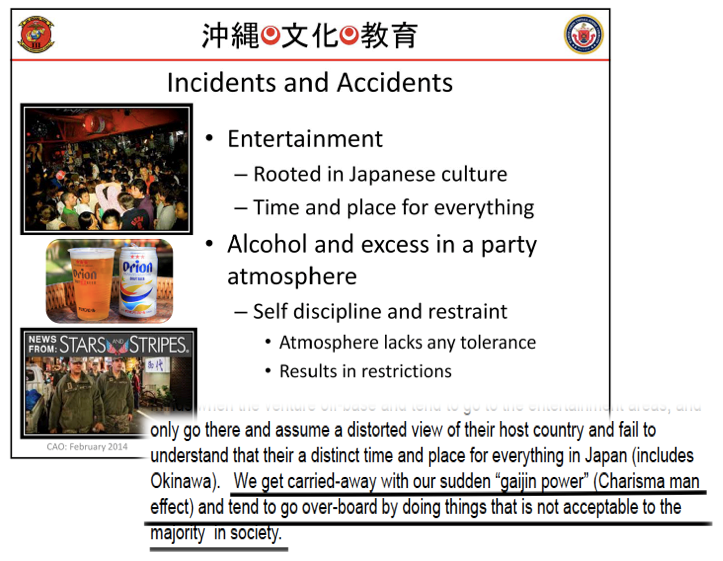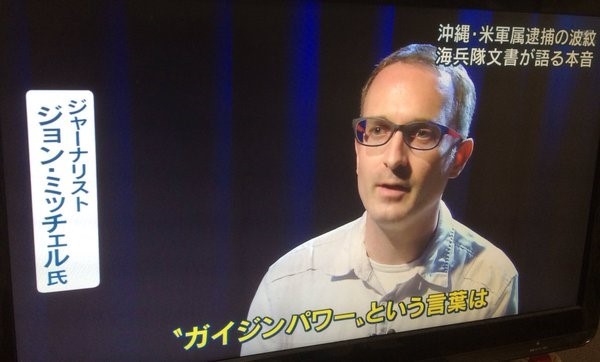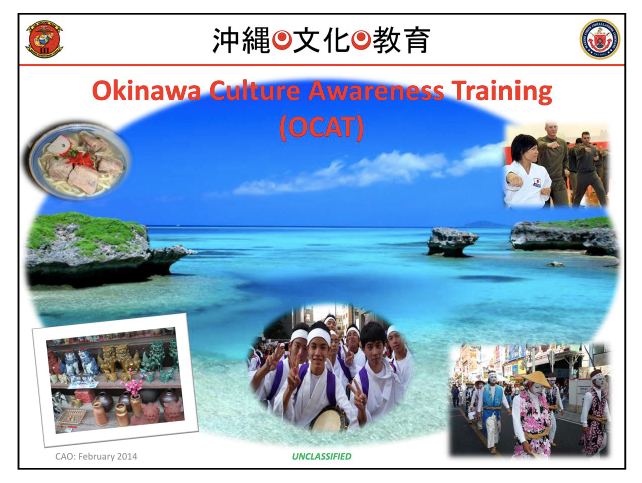Documents from the United States Marine Corps reveal that lectures purported to improve Marines’ understanding of Okinawa instead disparage local residents and politicians, downplay military crimes and mislead service members about the island’s 27-year occupation by the U.S.1
Obtained under the U.S. Freedom of Information Act, the documents consist of scripts and slides for “Okinawa Cultural Awareness Training” (OCAT), the orientation lectures given to new arrivals to the island. The released documents, dated February 2014 and February 2016, originate from the Okinawa USMC Joint Reception Center at Camp Butler and Marine Corps Community Services.2
OCAT is the only mandatory training related to Okinawan history and culture for the majority of Marines and their dependants, many of whom, the documents explain, are stationed on the island for the first time. Given that this is the sole official training for these service members, it is likely to have a formative impact on their understanding of the island and their interactions with local residents.
OCAT: On Okinawan residents and politicians
Among the documents are numerous derogatory comments related to Okinawans and local politicians. One slide describes how public opinion on the island, tends to be “self-serving” and characterized by “double standards”. For Okinawans, according to the talk’s accompanying slides, “It pays to complain. Anywhere offense can be taken it will be used.”
Elsewhere, the lectures claim “the politics (sic) of Okinawa use the US Military base issue for leverage on a number of levels locally and nationally.” The lectures accuse Okinawan politicians of raising grievances with the military bases which are “real, invented, exaggerated, or otherwise not fully understood”. They also say that “the media and local politics (sic) will eagerly report on half-truths and unconfirmed allegations in order to continue to underscore their burden and extract political mileage to further certain agendas.”
OCAT: On military crimes
In March, a U.S. sailor allegedly raped a Japanese tourist in Naha City and in April a former U.S. Marine allegedly murdered a 20-year old office worker in Uruma City. These two offences are just two that are part of a prolonged pattern of military violence on the island. According to Okinawa Prefectural Police, between 2006 and 2015, members of the US military, their dependents and military employees committed serious offences (murder, robbery, arson and rape) at a rate 2.3 times that of the local population.3 On a longer chronological scale, the rate of military-related serious crimes is 3.5 times that of the local population in the 44 years since Okinawa’s reversion to Japanese control in 1972.4
 |
The true number of offenses committed by U.S. service members, their dependents and civilian employees is likely even higher because crimes committed on-base are not included in these statistics. Such crimes are handled by military courts or by returning suspects to the U.S. for trial. For example, in 2012, a Kadena airman was sentenced to life in prison by a military court for murdering a fellow service member; while last July a Kadena worker was sentenced by a court in Minnesota to 5 years for sexually assaulting a minor at the air base.5
However none of this is detailed in the OCAT lectures which, instead, depict the military as good neighbours. “SOFA status personnel make-up less than 4% of Okinawa’s total population. They account for less than 1% of the crime and traffic incidents on Okinawa,” OCAT lectures state.
Additionally, the OCAT lectures link military crimes to what they call “gaijin power”. One section from a February 2014 talk headed “Incidents and Accidents”, states, “We get carried-away with our sudden “gaijin power” (Charisma man effect) and tend to go over-board by doing things that is (sic) not acceptable to the majority in society.”
They also state that many Okinawans “do not feel safe if they are alone at night and hear footsteps behind them and see one or more American GIs.” Blaming the reaction on “too many past liberty-related incidents”, it states how U.S. Marines “see ourselves as the good guys”.
The above comment is particularly chilling given the circumstances in which the 20-year old woman was murdered while walking at night on the island in April.
Referring to the 1995 gang rape of a young girl by three U.S. service members, the lecture notes attribute the subsequent protests to “the handling of (the crime) by the Japanese government.” Not mentioned is the public anger sparked by Admiral Richard C. Macke, the commander of the U.S. Forces in the Pacific, who suggested hiring a prostitute would have been cheaper than renting the car the service members used to abduct the girl. Macke was forced to resign over the statement.6
 |
OCAT: On history
The lectures discuss the pre-twentieth century history on Okinawa in relative detail, but, when dealing with more recent events, the contents of the lectures mislead service members. For example, the period of U.S. military control (1945~1972) is described as a time when: “Okinawa’s first hospital was established, along with a civilian newspaper (Ryukyu Shimpo), bank, legal and political system. Okinawa had restarted foreign trade and its civil government was in place throughout the island by 1950.” Discussed only briefly is how, in order to construct the military bases, the US military forced “people off their land. . . The compensation was small, and the land-leases were long.”
The lectures omit the range of human rights abuses which accompanied the 27-year occupation. In relation to the aforementioned land seizures, they neglect to explain that, by 1955, 250,000 residents had been displaced out of a total population on the main island of 675,000.7 Also glossed over are the fact that Okinawans were denied the right to elect the island’s High Commissioner, unions were banned and the press was censored. Abve all, the lectures fail to explain the high rate of military crimes during the U.S. occupation or the light punishments often given to their perpetrators.8
OCAT: The reaction
After the contents of the OCAT lectures were revealed by The Japan Times on May 25, the issue was reported widely in Japanese language media, including national TV networks.
Okinawa’s governor, Onaga Takeshi, called the training, “A prime example of (the U.S. military’s) arrogant attitude” towards Okinawans.9
In a press conference on May 27, head of the USMC in Japan, Lt. Gen. Lawrence D. Nicholson, made no attempt to explain the contents of the lectures, who had written them or their potential influence on new arrivals’ behaviour to Okinawans. Instead he criticised media coverage of the issue as “very pointed in one direction” and “not fair”.10
However, Nicholson told journalists, “The content of the OCAT (Okinawa Culture Awareness Training) briefing we will continue to review. I welcome open communications with the Okinawan community and if we’re saying something in there that you think is unfair then let’s have a discussion.”
 |
Following the alleged rape-murder in April, the USMC on Okinawa has faced unprecedented pressure. On May 26, Okinawa Prefectural Assembly passed its first ever resolution to demand the withdrawal of the US Marines from the island; on June 19, 65,000 people attended a mass demonstration in Naha whose demands included the withdrawal of all seven USMC bases from their island.11
The OCAT lectures are the latest in a string of derogatory comments made by USMC officials against Okinawans. In 2015, Major Tim Kao, Camp Commander of the Northern Training Area reportedly accused demonstrators of being paid to be there and he criticized Governor Onaga Takeshi, a long-term member of the Liberal Democatic Party, of being supported by the island’s communist party. Captain Caleb D. Eames, Deputy Public Affairs Officer for the Marine Corps Installations Pacific, likened Okinawan demonstrators injured in clashes with the authorities to play-acting professional footballers and said, “the attempt to appear injured is laughable when you see it in person.” Eames also accused protesters of “jabbing American employees with sticks” and “yelling English profanity and curse words” at his children.
Meanwhile, in March 2015 Robert Eldridge, USMC Deputy Assistant Chief of Staff of Government and External Affairs, was fired following a leak of base surveillance footage to a Japanese far-right group. Prior to his dismissal, he had appeared on a Japanese neo-nationalist TV network and branded Okinawan demonstrations “hate speech”. He had also accused Okinawan demonstrators of “mob rule” and claimed there had been “many physical attacks on Americans” by protestors.12
Notes
The date, February 2014, is printed on the bottom left corner of all 17 slides of one of the released documents. However on the other package, the date 2016/2/11 only appears on the final three sides. On page 17 of this document, the comment, “At the time of this writing, three of its (Democratic Party of Japan) party heads have become prime minister in less than two years,” suggests the script may have been written some time in 2011.
A report into the murder at Kadena Air Base is available here; the FBI investigation is available here.
Irvin Molotsky, “Admiral has to quit over his comments on Okinawa rape”, New York Times, November 18, 1995.
For an in-depth discussion of U.S. abuses of human rights on Okinawa, see Miyume Tanji, Myth, Protest and Struggle in Okinawa, Routledge, London, 2006.
“Okinawa Prefectural Assembly demands removal of US Marines from Okinawa”, Ryukyu Shimpo, May 27, 2016. Available here; “65,000 people in rally mourn and demand withdrawal of Marines from Okinawa”, Ryukyu Shimpo, June 19, 2016. Available here.
Jon Mitchell, “On Okinawa, U.S. Marines raise tensions with accusations and arrests of peace campaigners”, The Asia-Pacific Journal, March 2, 2015. Available here.




